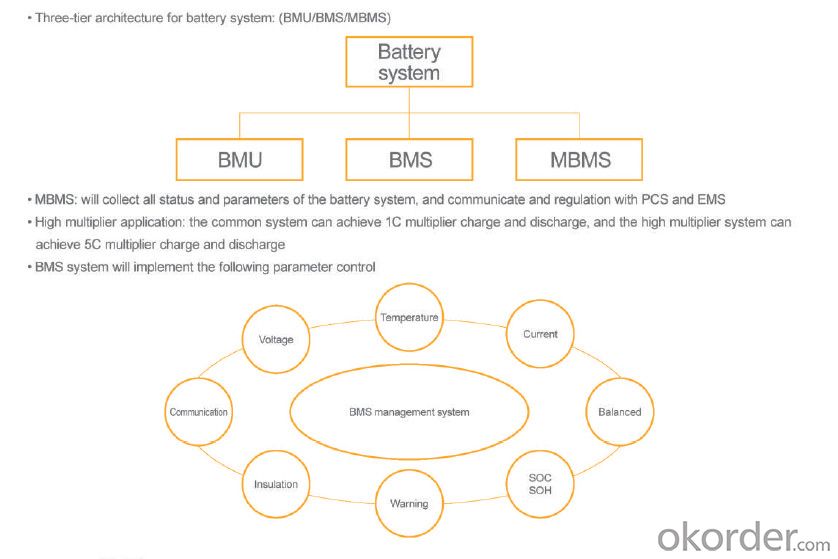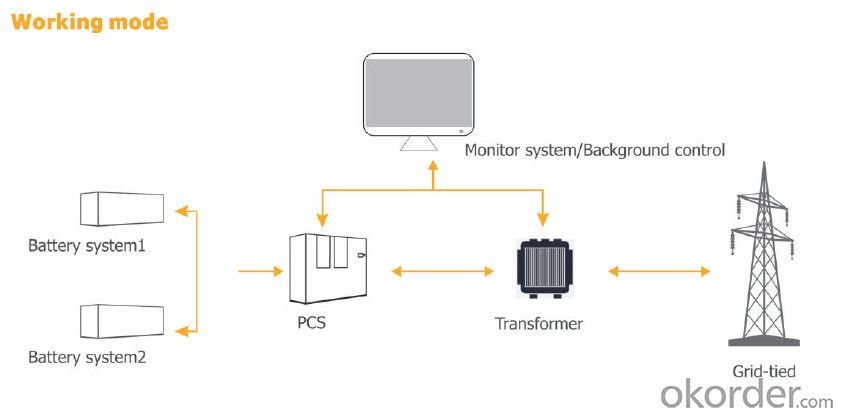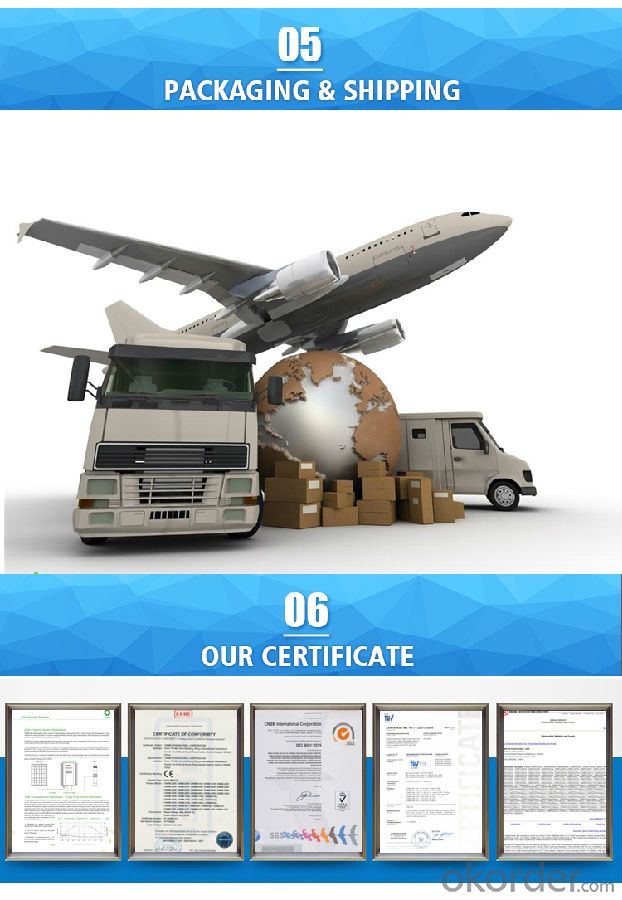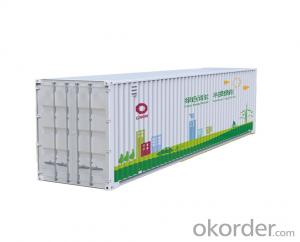1 Mwh Container Energy Storage System LiFePO4 battery for remote place ESS
- Loading Port:
- Shanghai
- Payment Terms:
- TT OR LC
- Min Order Qty:
- 1 unit
- Supply Capability:
- 50 unit/month
OKorder Service Pledge
OKorder Financial Service
You Might Also Like
Item specifice
Features:
1.LiFePO4 lithium battery
* Long-cyclelife (up to 2000 cycles)
* High specific energy
* High specific power,
* High energy conversion efficiency
* Easy installation
2.Intelligent battery management system(BMS)
* Precise voltage detection
* Precise current detection
* Precise temperature detection
* Precise SOC evaluation
* Battery protection
* Active balance
* Remote monitoring system interface
3.Unique Battery thermal management technology
According to aerodynamics and hydrodynamics theory, we has designed a unique thermal control system model for batteries. The model
has been extensively tested, by carrying out lots of temperature analysis experiments, to make sure optimization and uniformity
for each unit in the energy storage system is guaranteed.
Advantage:
First-class R&D team: Our R&D colleagues are from the TOP3 Lithium battery companies in China. we have very rich experience in lithium battery design, electronics, system testing and real application.
Strict Quality Control: We set a series strict QC standards include battery battery appearance, package, internal structure,charge / discharge performance, IP request etc. We strictly obey this standards to make sure every customers can get high quality battery from us.
Customer first culture: 80% of our customers are 5 years above close win-win cooperation partner. We treat our customers as our friends, family members. Every batteries we produced, sold are priceless trust from customers, so we cherish it and we keep a grateful, royalty and honesty heart to our customers.






- Q:Can solar energy systems be used in areas with limited access to emergency services?
- Yes, solar energy systems can be used in areas with limited access to emergency services. Solar energy systems operate independently of the power grid, making them suitable for remote locations. They can provide a reliable and sustainable source of electricity, enabling essential services such as lighting, communication, and medical equipment in emergencies. Additionally, solar energy systems can be combined with energy storage solutions to ensure continuous power supply even during periods of low sunlight or at night.
- Q:How do solar energy systems contribute to reducing greenhouse gas emissions?
- Solar energy systems contribute to reducing greenhouse gas emissions in several ways. Firstly, they generate electricity without burning fossil fuels, which are the primary source of greenhouse gas emissions. By relying on the sun's energy, solar systems eliminate the need for power plants that release carbon dioxide and other pollutants. Secondly, solar energy reduces the demand for traditional electricity generation, which often relies on fossil fuels. As solar power becomes more widespread, the overall carbon footprint of the energy sector decreases. Lastly, solar energy systems can be integrated into buildings, reducing the need for energy transportation and transmission, which further minimizes greenhouse gas emissions. Overall, solar energy systems play a crucial role in transitioning to a cleaner and more sustainable energy future, helping to combat climate change and reduce greenhouse gas emissions.
- Q:Can a solar energy system be installed on a hospital or healthcare facility?
- Yes, a solar energy system can be installed on a hospital or healthcare facility. In fact, many hospitals and healthcare facilities around the world have already implemented solar energy systems as a way to reduce their carbon footprint and lower their energy costs. Solar panels can be installed on the rooftop of the facility or in an adjacent open space, depending on the available area. These systems can generate electricity from sunlight, which can be used to power various operations within the hospital, including lighting, heating, and cooling systems, as well as medical equipment. The use of solar energy not only helps the facility save on energy costs but also promotes sustainability and environmental responsibility. Additionally, solar energy systems can provide a reliable and independent source of power, which can be crucial during emergencies or power outages, ensuring uninterrupted healthcare services.
- Q:What is the impact of hail on solar panels?
- Hail can have a detrimental impact on solar panels by causing physical damage to the panels, such as cracks or dents. This damage can lead to decreased efficiency and potential system failure. Additionally, hail can also damage the protective coating on the panels, making them more susceptible to corrosion and long-term degradation. Regular maintenance and protective measures, such as using hail-resistant materials or installing protective covers, can help mitigate the impact of hail on solar panels.
- Q:Can solar energy systems be used in conjunction with wind energy systems?
- Yes, solar energy systems can be used in conjunction with wind energy systems. Both solar and wind energy are renewable sources and can complement each other in terms of their availability and energy generation patterns. Combining both systems allows for a more consistent and reliable energy supply, as solar energy is typically more abundant during the day, while wind energy is often stronger at night and during different seasons. By integrating solar and wind energy systems, we can maximize the overall energy output and enhance the sustainability of our power generation.
- Q:Can a solar energy system be used to charge electric vehicles?
- It is indeed possible to utilize a solar energy system for the purpose of charging electric vehicles. The sun's rays are harnessed by solar panels, also referred to as photovoltaic (PV) panels, to generate electricity. This electricity can then be employed to charge the batteries of electric vehicles. The PV panels capture sunlight and convert it into direct current (DC) electricity. Subsequently, an inverter is used to transform this DC electricity into alternating current (AC) electricity, which aligns with the charging requirements of electric vehicles. By establishing a link between the solar energy system and an electric vehicle charging station, the solar-generated electricity can directly charge the vehicle's battery. This renewable energy source not only diminishes the dependence on fossil fuels but also aids in reducing the emission of greenhouse gases associated with transportation. Moreover, any surplus electricity generated by the solar panel system during daylight hours can be stored in batteries or returned to the grid for future use, guaranteeing a continuous and sustainable power supply for charging electric vehicles.
- Q:Can solar energy systems be installed without professional help?
- No, it is not recommended to install solar energy systems without professional help. Proper installation requires expertise and knowledge of electrical and structural considerations to ensure the system's safety, efficiency, and compliance with local regulations. Hiring a professional ensures that the installation is done correctly and maximizes the benefits of solar energy.
- Q:How do solar energy systems affect the grid?
- The grid can be affected both positively and negatively by solar energy systems. On the positive side, these systems can decrease the demand for electricity from traditional power plants, particularly during peak hours. This can alleviate strain on the grid and lessen the need for additional generation capacity. Furthermore, the decentralization of the grid can be facilitated by solar energy systems. Generating electricity at the point of use can reduce transmission and distribution losses, resulting in a more efficient energy system. Additionally, grid resilience can be enhanced as power can be produced locally, reducing vulnerability to disruptions in the transmission and distribution infrastructure. However, challenges can arise when it comes to solar energy systems and the grid. One of the main issues is intermittency, as solar energy generation depends on the availability of sunlight, which varies throughout the day and is absent at night. This can lead to fluctuations in the supply of electricity, necessitating the balancing of the system by grid operators to ensure a stable supply. To tackle this issue, energy storage systems, such as batteries, may need to be invested in by grid operators. These systems can store excess solar energy during peak production and release it during periods of low production, thereby smoothing out the intermittent nature of solar energy and improving grid stability. Additionally, the integration of large-scale solar energy systems into the grid may require significant upgrades to the transmission and distribution infrastructure. These upgrades are essential to accommodate the increased flow of electricity from distributed generation sources and guarantee the reliable and safe operation of the grid. In conclusion, solar energy systems can have a positive impact on the grid by reducing demand from traditional power plants and decentralizing the energy system. However, challenges related to intermittency and the need for grid upgrades must be addressed. Overall, with proper planning and investment, solar energy systems can play a crucial role in transitioning towards a more sustainable and resilient grid.
- Q:Can solar energy systems be installed on mobile homes?
- Yes, solar energy systems can be installed on mobile homes. In fact, they are a popular choice for mobile homeowners looking to reduce their reliance on traditional energy sources and lower their carbon footprint. Solar panels can be mounted on rooftops or on the ground near the mobile home, providing a sustainable and renewable source of electricity.
- Q:What is the impact of hurricanes on solar panels?
- The impact of hurricanes on solar panels can be significant. The powerful winds that accompany hurricanes have the potential to damage or dislodge solar panels from their mountings, especially if they are not properly secured. This can result in the complete destruction of the panels or render them ineffective in generating electricity. In addition, the debris that is propelled through the air during a hurricane can cause physical damage to the solar panels, such as cracks or shattered glass. This damage can impair the functionality of the panels and reduce their efficiency in converting sunlight into electricity. Moreover, the heavy rainfall that often accompanies hurricanes poses a threat to solar panels. If water infiltrates the panels, it can lead to electrical short circuits or damage to the internal components, rendering them inoperable. Furthermore, hurricanes can lead to power outages, which can affect the functionality of solar panels. If the electric grid is offline, the solar panels may be unable to send excess energy back into the grid or receive power from it, limiting their ability to generate electricity. However, it is important to note that solar panels are designed to withstand various weather conditions, including strong winds and heavy rain. When installed and maintained properly, solar panels have a higher chance of surviving a hurricane with minimal damage. Additionally, advancements in solar panel technology, such as stronger glass and improved mounting systems, are continuously being made to increase their resilience to extreme weather events. In conclusion, while hurricanes can negatively impact solar panels, taking proper precautions and conducting regular maintenance can enhance their durability and make them a viable and sustainable energy option even in areas prone to hurricanes.
1. Manufacturer Overview |
|
|---|---|
| Location | |
| Year Established | |
| Annual Output Value | |
| Main Markets | |
| Company Certifications | |
2. Manufacturer Certificates |
|
|---|---|
| a) Certification Name | |
| Range | |
| Reference | |
| Validity Period | |
3. Manufacturer Capability |
|
|---|---|
| a)Trade Capacity | |
| Nearest Port | |
| Export Percentage | |
| No.of Employees in Trade Department | |
| Language Spoken: | |
| b)Factory Information | |
| Factory Size: | |
| No. of Production Lines | |
| Contract Manufacturing | |
| Product Price Range | |
Send your message to us
1 Mwh Container Energy Storage System LiFePO4 battery for remote place ESS
- Loading Port:
- Shanghai
- Payment Terms:
- TT OR LC
- Min Order Qty:
- 1 unit
- Supply Capability:
- 50 unit/month
OKorder Service Pledge
OKorder Financial Service
Similar products
New products
Hot products
Related keywords





























